Quanyu Dai
Think Socially via Cognitive Reasoning
Sep 26, 2025Abstract:LLMs trained for logical reasoning excel at step-by-step deduction to reach verifiable answers. However, this paradigm is ill-suited for navigating social situations, which induce an interpretive process of analyzing ambiguous cues that rarely yield a definitive outcome. To bridge this gap, we introduce Cognitive Reasoning, a paradigm modeled on human social cognition. It formulates the interpretive process into a structured cognitive flow of interconnected cognitive units (e.g., observation or attribution), which combine adaptively to enable effective social thinking and responses. We then propose CogFlow, a complete framework that instills this capability in LLMs. CogFlow first curates a dataset of cognitive flows by simulating the associative and progressive nature of human thought via tree-structured planning. After instilling the basic cognitive reasoning capability via supervised fine-tuning, CogFlow adopts reinforcement learning to enable the model to improve itself via trial and error, guided by a multi-objective reward that optimizes both cognitive flow and response quality. Extensive experiments show that CogFlow effectively enhances the social cognitive capabilities of LLMs, and even humans, leading to more effective social decision-making.
Expectation Confirmation Preference Optimization for Multi-Turn Conversational Recommendation Agent
Jun 17, 2025Abstract:Recent advancements in Large Language Models (LLMs) have significantly propelled the development of Conversational Recommendation Agents (CRAs). However, these agents often generate short-sighted responses that fail to sustain user guidance and meet expectations. Although preference optimization has proven effective in aligning LLMs with user expectations, it remains costly and performs poorly in multi-turn dialogue. To address this challenge, we introduce a novel multi-turn preference optimization (MTPO) paradigm ECPO, which leverages Expectation Confirmation Theory to explicitly model the evolution of user satisfaction throughout multi-turn dialogues, uncovering the underlying causes of dissatisfaction. These causes can be utilized to support targeted optimization of unsatisfactory responses, thereby achieving turn-level preference optimization. ECPO ingeniously eliminates the significant sampling overhead of existing MTPO methods while ensuring the optimization process drives meaningful improvements. To support ECPO, we introduce an LLM-based user simulator, AILO, to simulate user feedback and perform expectation confirmation during conversational recommendations. Experimental results show that ECPO significantly enhances CRA's interaction capabilities, delivering notable improvements in both efficiency and effectiveness over existing MTPO methods.
KnowTrace: Bootstrapping Iterative Retrieval-Augmented Generation with Structured Knowledge Tracing
May 26, 2025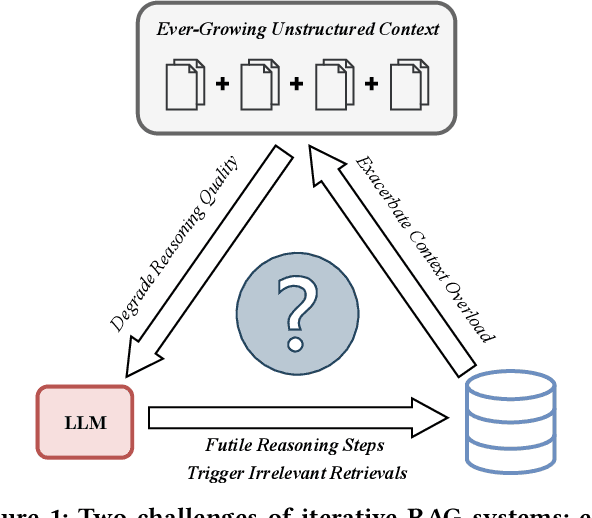
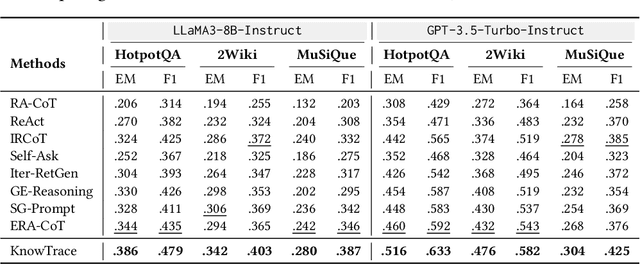
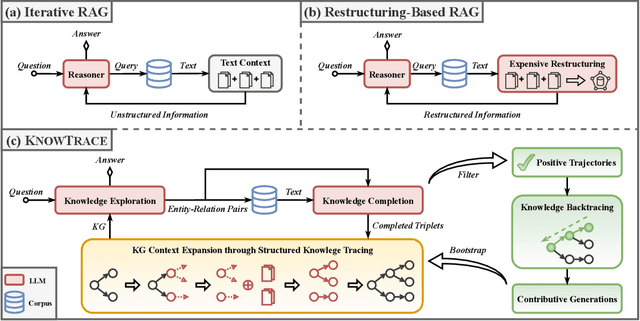
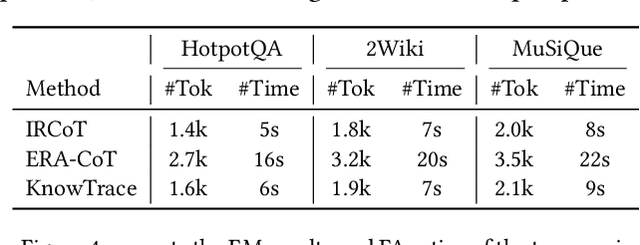
Abstract:Recent advances in retrieval-augmented generation (RAG) furnish large language models (LLMs) with iterative retrievals of relevant information to handle complex multi-hop questions. These methods typically alternate between LLM reasoning and retrieval to accumulate external information into the LLM's context. However, the ever-growing context inherently imposes an increasing burden on the LLM to perceive connections among critical information pieces, with futile reasoning steps further exacerbating this overload issue. In this paper, we present KnowTrace, an elegant RAG framework to (1) mitigate the context overload and (2) bootstrap higher-quality multi-step reasoning. Instead of simply piling the retrieved contents, KnowTrace autonomously traces out desired knowledge triplets to organize a specific knowledge graph relevant to the input question. Such a structured workflow not only empowers the LLM with an intelligible context for inference, but also naturally inspires a reflective mechanism of knowledge backtracing to identify contributive LLM generations as process supervision data for self-bootstrapping. Extensive experiments show that KnowTrace consistently surpasses existing methods across three multi-hop question answering benchmarks, and the bootstrapped version further amplifies the gains.
Beyond Single-Point Judgment: Distribution Alignment for LLM-as-a-Judge
May 18, 2025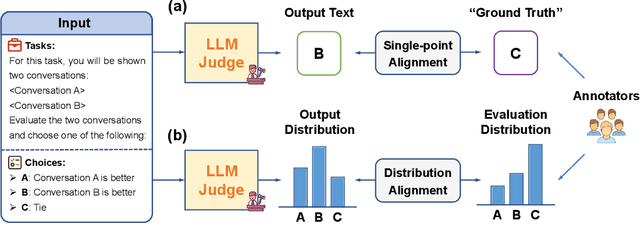
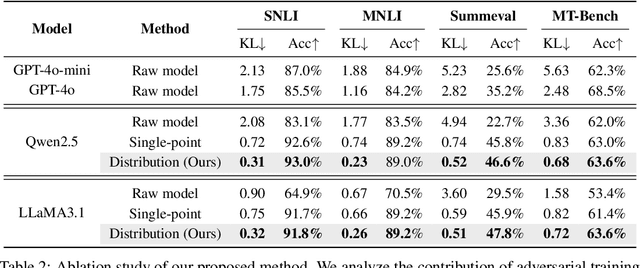
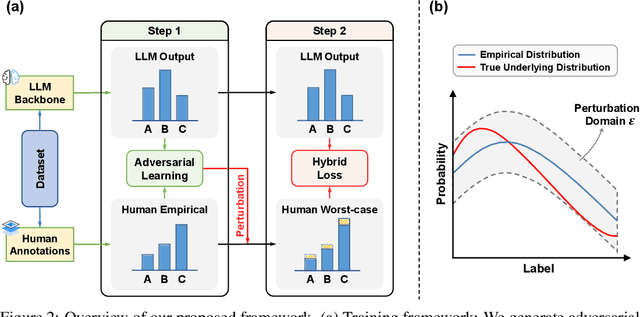
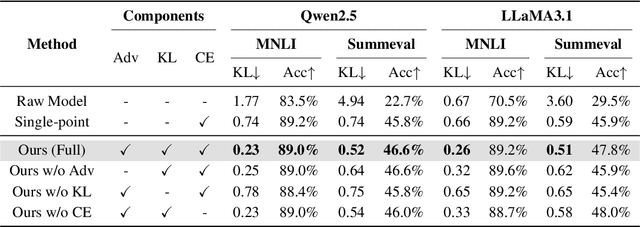
Abstract:LLMs have emerged as powerful evaluators in the LLM-as-a-Judge paradigm, offering significant efficiency and flexibility compared to human judgments. However, previous methods primarily rely on single-point evaluations, overlooking the inherent diversity and uncertainty in human evaluations. This approach leads to information loss and decreases the reliability of evaluations. To address this limitation, we propose a novel training framework that explicitly aligns the LLM-generated judgment distribution with empirical human distributions. Specifically, we propose a distributional alignment objective based on KL divergence, combined with an auxiliary cross-entropy regularization to stabilize the training process. Furthermore, considering that empirical distributions may derive from limited human annotations, we incorporate adversarial training to enhance model robustness against distribution perturbations. Extensive experiments across various LLM backbones and evaluation tasks demonstrate that our framework significantly outperforms existing closed-source LLMs and conventional single-point alignment methods, with improved alignment quality, evaluation accuracy, and robustness.
MemEngine: A Unified and Modular Library for Developing Advanced Memory of LLM-based Agents
May 04, 2025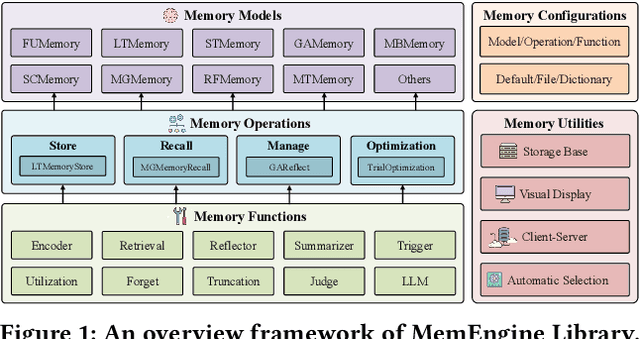
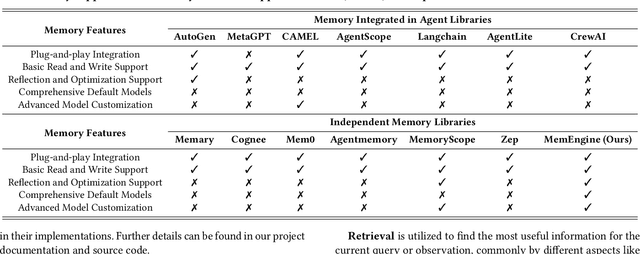
Abstract:Recently, large language model based (LLM-based) agents have been widely applied across various fields. As a critical part, their memory capabilities have captured significant interest from both industrial and academic communities. Despite the proposal of many advanced memory models in recent research, however, there remains a lack of unified implementations under a general framework. To address this issue, we develop a unified and modular library for developing advanced memory models of LLM-based agents, called MemEngine. Based on our framework, we implement abundant memory models from recent research works. Additionally, our library facilitates convenient and extensible memory development, and offers user-friendly and pluggable memory usage. For benefiting our community, we have made our project publicly available at https://github.com/nuster1128/MemEngine.
Improving Retrospective Language Agents via Joint Policy Gradient Optimization
Mar 03, 2025Abstract:In recent research advancements within the community, large language models (LLMs) have sparked great interest in creating autonomous agents. However, current prompt-based agents often heavily rely on large-scale LLMs. Meanwhile, although fine-tuning methods significantly enhance the capabilities of smaller LLMs, the fine-tuned agents often lack the potential for self-reflection and self-improvement. To address these challenges, we introduce a novel agent framework named RetroAct, which is a framework that jointly optimizes both task-planning and self-reflective evolution capabilities in language agents. Specifically, we develop a two-stage joint optimization process that integrates imitation learning and reinforcement learning, and design an off-policy joint policy gradient optimization algorithm with imitation learning regularization to enhance the data efficiency and training stability in agent tasks. RetroAct significantly improves the performance of open-source models, reduces dependency on closed-source LLMs, and enables fine-tuned agents to learn and evolve continuously. We conduct extensive experiments across various testing environments, demonstrating RetroAct has substantial improvements in task performance and decision-making processes.
EAGER-LLM: Enhancing Large Language Models as Recommenders through Exogenous Behavior-Semantic Integration
Feb 20, 2025Abstract:Large language models (LLMs) are increasingly leveraged as foundational backbones in the development of advanced recommender systems, offering enhanced capabilities through their extensive knowledge and reasoning. Existing llm-based recommender systems (RSs) often face challenges due to the significant differences between the linguistic semantics of pre-trained LLMs and the collaborative semantics essential for RSs. These systems use pre-trained linguistic semantics but learn collaborative semantics from scratch via the llm-Backbone. However, LLMs are not designed for recommendations, leading to inefficient collaborative learning, weak result correlations, and poor integration of traditional RS features. To address these challenges, we propose EAGER-LLM, a decoder-only llm-based generative recommendation framework that integrates endogenous and exogenous behavioral and semantic information in a non-intrusive manner. Specifically, we propose 1)dual-source knowledge-rich item indices that integrates indexing sequences for exogenous signals, enabling efficient link-wide processing; 2)non-invasive multiscale alignment reconstruction tasks guide the model toward a deeper understanding of both collaborative and semantic signals; 3)an annealing adapter designed to finely balance the model's recommendation performance with its comprehension capabilities. We demonstrate EAGER-LLM's effectiveness through rigorous testing on three public benchmarks.
A Survey of Personalized Large Language Models: Progress and Future Directions
Feb 17, 2025Abstract:Large Language Models (LLMs) excel in handling general knowledge tasks, yet they struggle with user-specific personalization, such as understanding individual emotions, writing styles, and preferences. Personalized Large Language Models (PLLMs) tackle these challenges by leveraging individual user data, such as user profiles, historical dialogues, content, and interactions, to deliver responses that are contextually relevant and tailored to each user's specific needs. This is a highly valuable research topic, as PLLMs can significantly enhance user satisfaction and have broad applications in conversational agents, recommendation systems, emotion recognition, medical assistants, and more. This survey reviews recent advancements in PLLMs from three technical perspectives: prompting for personalized context (input level), finetuning for personalized adapters (model level), and alignment for personalized preferences (objective level). To provide deeper insights, we also discuss current limitations and outline several promising directions for future research. Updated information about this survey can be found at the https://github.com/JiahongLiu21/Awesome-Personalized-Large-Language-Models.
MAJL: A Model-Agnostic Joint Learning Framework for Music Source Separation and Pitch Estimation
Jan 07, 2025



Abstract:Music source separation and pitch estimation are two vital tasks in music information retrieval. Typically, the input of pitch estimation is obtained from the output of music source separation. Therefore, existing methods have tried to perform these two tasks simultaneously, so as to leverage the mutually beneficial relationship between both tasks. However, these methods still face two critical challenges that limit the improvement of both tasks: the lack of labeled data and joint learning optimization. To address these challenges, we propose a Model-Agnostic Joint Learning (MAJL) framework for both tasks. MAJL is a generic framework and can use variant models for each task. It includes a two-stage training method and a dynamic weighting method named Dynamic Weights on Hard Samples (DWHS), which addresses the lack of labeled data and joint learning optimization, respectively. Experimental results on public music datasets show that MAJL outperforms state-of-the-art methods on both tasks, with significant improvements of 0.92 in Signal-to-Distortion Ratio (SDR) for music source separation and 2.71% in Raw Pitch Accuracy (RPA) for pitch estimation. Furthermore, comprehensive studies not only validate the effectiveness of each component of MAJL, but also indicate the great generality of MAJL in adapting to different model architectures.
MemSim: A Bayesian Simulator for Evaluating Memory of LLM-based Personal Assistants
Sep 30, 2024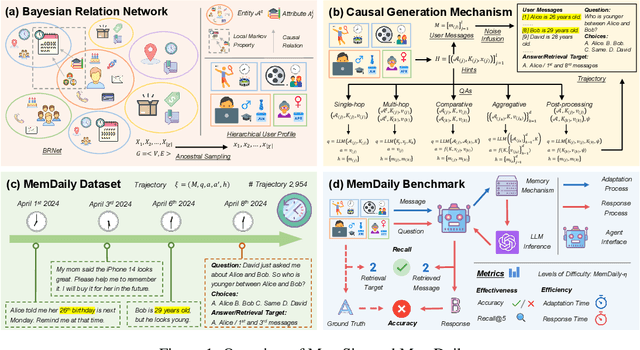
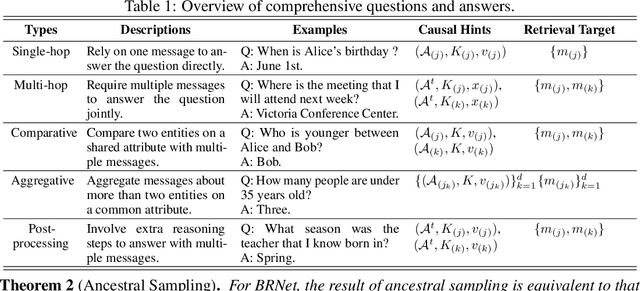
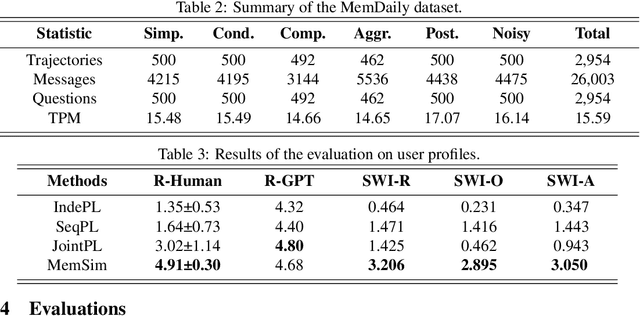

Abstract:LLM-based agents have been widely applied as personal assistants, capable of memorizing information from user messages and responding to personal queries. However, there still lacks an objective and automatic evaluation on their memory capability, largely due to the challenges in constructing reliable questions and answers (QAs) according to user messages. In this paper, we propose MemSim, a Bayesian simulator designed to automatically construct reliable QAs from generated user messages, simultaneously keeping their diversity and scalability. Specifically, we introduce the Bayesian Relation Network (BRNet) and a causal generation mechanism to mitigate the impact of LLM hallucinations on factual information, facilitating the automatic creation of an evaluation dataset. Based on MemSim, we generate a dataset in the daily-life scenario, named MemDaily, and conduct extensive experiments to assess the effectiveness of our approach. We also provide a benchmark for evaluating different memory mechanisms in LLM-based agents with the MemDaily dataset. To benefit the research community, we have released our project at https://github.com/nuster1128/MemSim.
 Add to Chrome
Add to Chrome Add to Firefox
Add to Firefox Add to Edge
Add to Edge